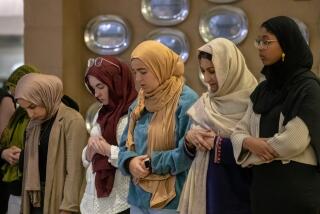Rite at Base May Bring New Respect for Islam
- Share via
For Muslims in Orange County and elsewhere, the celebration of Eid al-Fitr at the Tustin Marine base last week may signal the start of an era of greater tolerance and respect for Islam in America.
It also could herald the mainstreaming of Muslims, like that of Roman Catholics, Mormons and Jews in the American experience.
It took the combined eleventh-hour efforts of Mormon Bishop Tom Thorkelson, Navy Protestant Chaplain Tom Atkins and Marine Brig. Gen. Robert Magnus, who is Jewish, to turn an old blimp hanger into a place of worship for several thousand Muslims. Thorkelson, whose home overlooks the base, got the idea after hearing that the Muslims needed a covered facility for the Eid festival. He called Atkins, who liked it immediately. Only days before the event, Atkins e-mailed the general, who gave his approval--as long as it was open to everyone.
The scene of Marines, with their characteristic aplomb, directing worshipers to the huge hangar to celebrate the close of the Ramadan fast was striking. It illustrated how far we had come from the 1983 bombing of the Marine barracks in Beirut by Muslim fanatics--and the extremely negative impressions of Islam it created. And what a welcome contrast to recent treatment of Muslims in this country.
Following the April 19, 1995, bombing of the Murrah Federal Building in Oklahoma City, many Americans, and some news agencies, initially assumed that Muslim terrorists were to blame. According to the Council on American-Islamic Relations, 216 anti-Muslim incidents were reported in the week following the bombing. These included verbal abuse (69%), threats of violence (26%), actual violence (5%) and civil rights abuses (1%).
Although the situation has improved since then, acts of religious bigotry against Muslims continue to occur: 240 between April 1996 and March 1997, according to the council.
The Marines’ hospitality had parallels in Washington, D.C., where, for the first time, Ramadan was officially acknowledged with the placing of the Muslim symbol, the crescent moon and star, near the White House.
Another sign of increased awareness of Islam was President Clinton’s inviting of an American Muslim, Asifa Quraishi, to attend a Jan. 12 advisory meeting on his civil rights initiative.
The Orange County Muslim community has helped create new attitudes toward Islam through the work of two of its leaders. Imam Dr. Muzammil Siddiqi, head of the Islamic Society of Orange County for the past 17 years, has been active in interfaith activities, particularly through his involvement in the Academy for Judaic, Christian and Islamic Society of North America. The organization attempts to provide a unified voice for the 6 million Muslims on this continent and helps provide educational, philanthropic and social services to local Muslim communities.
Shabbir Mansuri is the director of the Council on Islamic Education in Fountain Valley. Mansuri founded the organization in 1990 after his daughter Aasiya found errors about Islam in her sixth-grade social studies textbook and mentioned them to him.
That council has attained a national reputation as a valuable resource for K-12 educators, school administrators and publishers as they attempt to portray Islam, Muslim history and other underrepresented components of world history accurately in schools. The council has sponsored three national meetings of textbook authors and publishers, educators and scholars since its founding, and published a guide: “Teaching About Islam and Muslims in the Public School Classroom.”
Mansuri observed that the American Muslim community is unique in having representatives from every part of the world in its ranks. He thinks this community eventually will begin to have a positive influence on Muslims in other nations, for example, by convincing them that extremism is not the way to bring about political change.
Islam has much to offer America, just as other religions and cultures have contributed in the past to our unique national tapestry. America’s freedoms in turn, have helped give new shape to past immigrant groups, and the same will probably prove to be true with its Muslim citizens.
*
Benjamin J. Hubbard is a professor and chairman of the Department of Comparative Religion at Cal State Fullerton. He recently co-wrote “America’s Religions: An Educator’s Guide to Beliefs and Practices.” He can be reached by e-mail at bhubbard@fullerton.edu


